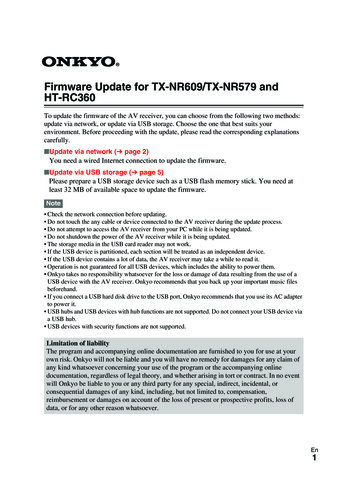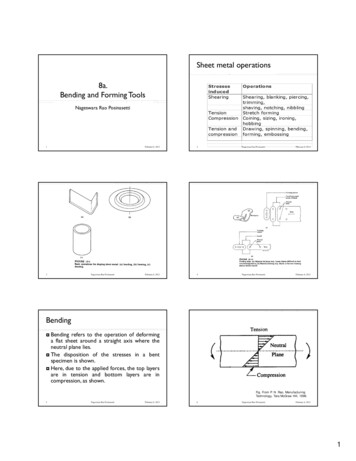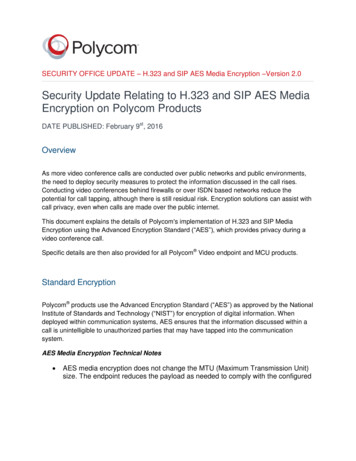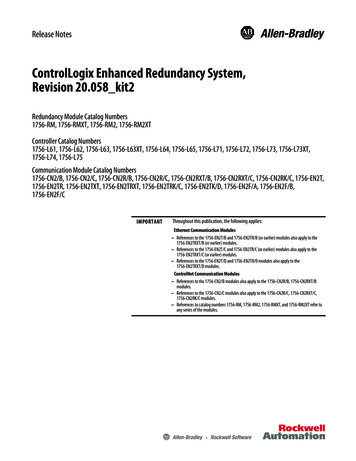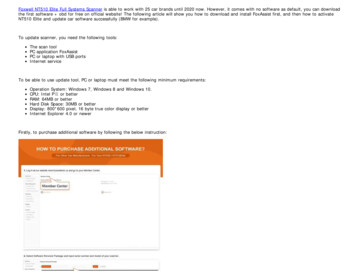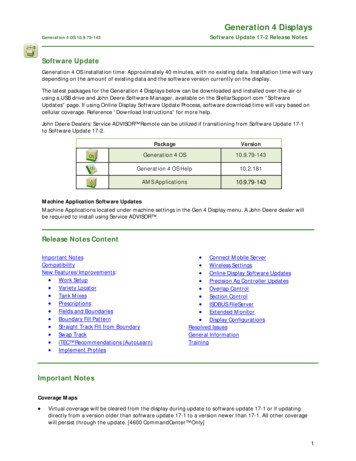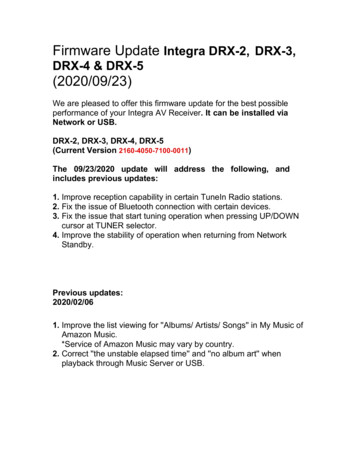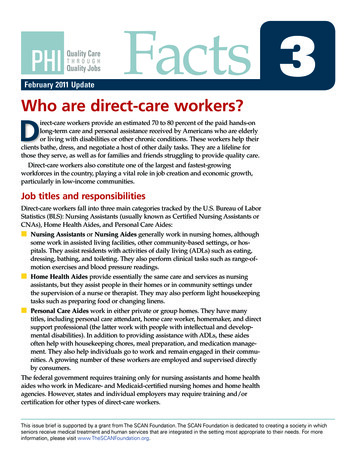
Transcription
February 2011 UpdateFacts 3Who are direct-care workers?irect-care workers provide an estimated 70 to 80 percent of the paid hands-onlong-term care and personal assistance received by Americans who are elderlyor living with disabilities or other chronic conditions. These workers help theirclients bathe, dress, and negotiate a host of other daily tasks. They are a lifeline forthose they serve, as well as for families and friends struggling to provide quality care.Direct-care workers also constitute one of the largest and fastest-growingworkforces in the country, playing a vital role in job creation and economic growth,particularly in low-income communities.Job titles and responsibilitiesDirect-care workers fall into three main categories tracked by the U.S. Bureau of LaborStatistics (BLS): Nursing Assistants (usually known as Certified Nursing Assistants orCNAs), Home Health Aides, and Personal Care Aides: Nursing Assistants or Nursing Aides generally work in nursing homes, althoughsome work in assisted living facilities, other community-based settings, or hospitals. They assist residents with activities of daily living (ADLs) such as eating,dressing, bathing, and toileting. They also perform clinical tasks such as range-ofmotion exercises and blood pressure readings. Home Health Aides provide essentially the same care and services as nursingassistants, but they assist people in their homes or in community settings underthe supervision of a nurse or therapist. They may also perform light housekeepingtasks such as preparing food or changing linens. Personal Care Aides work in either private or group homes. They have manytitles, including personal care attendant, home care worker, homemaker, and directsupport professional (the latter work with people with intellectual and developmental disabilities). In addition to providing assistance with ADLs, these aidesoften help with housekeeping chores, meal preparation, and medication management. They also help individuals go to work and remain engaged in their communities. A growing number of these workers are employed and supervised directlyby consumers.The federal government requires training only for nursing assistants and home healthaides who work in Medicare- and Medicaid-certified nursing homes and home healthagencies. However, states and individual employers may require training and/orcertification for other types of direct-care workers.This issue brief is supported by a grant from The SCAN Foundation. The SCAN Foundation is dedicated to creating a society in whichseniors receive medical treatment and human services that are integrated in the setting most appropriate to their needs. For moreinformation, please visit www.TheSCANFoundation.org.
PHI Facts2Number of workers and where they workCurrent employment. In 2008, over 3 million direct-care workers were employedin the three occupations: Nursing Aides, Orderlies and Attendants (1,470,000);Home Health Aides (922,000); and Personal Care Aides (817,000).Wide range of settings. Direct-care workers are employed in a range of settings:the consumer’s or family’s home; institutional settings such as nursing facilities,hospitals, and large facilities for persons with intellectual and developmentaldisabilities; community-based residential settings ranging from group homes toassisted living facilities; plus a wide range of non-residential day programs andother community support services.Home and community-based jobs dominate direct-care employment. Themajority of direct-care workers are now employed in home and community-basedsettings, and not in institutional settings such as nursing care facilities or hospitals.By 2018, home and community-based direct-care workers are likely to outnumberfacility workers by nearly two to one.The role of independent providers. A growing number of direct-care workerswork directly for consumers and their families rather than being employedthrough an agency. According to the BLS Employment Projections Program, nearlya quarter of Personal Care Aides in 2008 were either directly employed by privatehouseholds or were self-employed.Though substantial, this figure still significantly underestimates the number ofindependent providers of direct-care services. We know, for example, that over500,000 direct-care workers across the country work as independent providersunder the aegis of state or county public authorities. This suggests that the Bureauof Labor Statistics figure of 3.2 million direct-care workers in 2008 is too low.What they earn: wages, benefits, andeconomic securityWages. In 2009, the median hourly wage for all direct-care workers was 10.58.This was significantly less than the median wage for all U.S. workers ( 15.95). BothPersonal Care Aides and Home Health Aides earned under 10 per hour ( 9.46and 9.85, respectively); Nursing Aides, Orderlies, and Attendants earned 11.56.Over the past nine years, while Nursing Aides, Orderlies and Attendants haveseen a modest increase in their real (inflation-adjusted) wages to 9.22 (measuredin 1999 dollars), real wages for Home Health Aides have declined to under 8.00an hour. Real wages for Personal Care Aides have stagnated and remain around 7.50 an hour (see graph on p. 3).Low earnings and part-time work. A significant proportion of the direct-careworkforce is employed part time. In 2009, 48 percent of direct-care workersworked less than full-time, year-round. Over half of Personal Care Aides (58percent) worked part time or full time for only part of the year. Part-time hoursreduce overall earnings; thus in 2009, median annual earnings for direct-careworkers were 16,800.Health coverage. In 2009, an estimated 900,000 direct-care workers did not haveany health coverage. One in every four nursing home workers and more than athird of aides working in agency-based home care lacked health coverage. WhileNo. 3
3PHI FactsNo. 3Direct-Care Worker Median Wages Adjusted for Inflation (1999 dollars), 1999 –2009 9.00 9.22 8.50 8.29 8.00 8.21 7.50 7.85 7.50Nursing Aides,Orderlies & AttendantsHome Health AidesPersonal Care Aides 7.54 o thirds of civilian workers in America receive health coverage through anemployer, less than half of direct-care workers (47 percent) have such coverage.Poverty status. About 45 percent of direct-care workers live in households earningbelow 200 percent of the federal poverty level income, making them eligible formost state and federal public assistance programs.Reliance on public benefits. Nearly half of all direct-care workers (46 percent)live in households that receive one or more public benefits such as food stamps;Medicaid; or housing, child care, or energy assistance.Growing demand for direct-care jobsFast-growing occupations. Home Health Aides and Personal Care Aides areprojected to be the third and fourth fastest-growing occupations in the countrybetween 2008 and 2018, increasing by 50 percent and 46 percent, respectively.Nursing Aides, Orderlies and Attendants are expected to increase by 19 percent.Generating the most new jobs. All three direct-care occupations also are on thelist of top ten occupations projected to produce the most new jobs across theentire economy.Projected Growth in Direct-Care Jobs, 2018Home Health Aides20082018Nursing Aides, Orderlies& Attendants20082018Personal Care Aides
4PHI FactsNo. 3Historic proportionsThe latest 2008 employment estimate for the direct-care workforce surpasses the3 million mark. Projected demand calls for an additional 1.1 million new positionsby 2018.Direct-Care Workforce to Surpass 4.3 Million by 20185,000,0004,000,0004,322,0003,209,000Personal Care Aides3,000,000Home Health AidesNursing Aides, Orderlies& Attendants2,000,0001,000,000020082018At 4.3 million, in 2018, the direct-care workforce will reach historic proportions,exceeding: teachers from kindergarten through high school (3.9 million), all lawenforcement and public safety workers (3.7 million), fast food and counter workers (3.7 million), registered nurses (3.2 million), and all child care workers and preschool teachers (2.0 million).Largest Occupational Groups in U.S., 20184,863,900Retail Salespersons4,322,000Direct-Care WorkersTeachers fromK to 12th Grade3,944,900Cashiers3,695,500Fast Food &Counter WorkersLaw Enforcement &Public Safety Workers3,670,400Registered Nurses3,670,1003,200,200
5PHI FactsNo. 3The direct-care worker at a glance (2010)DemographicCharacteristicsEmployment and eFemale47%30%Employment Status16%7%White, African Hispanic, OtherNon- American LatinoHispanicAverage Age42404448AllIn nursing In home Self-employed ordirect-carecarehealth working directly forworkersfacilitiescareprivate householdsEmployed part timeor full time part ofthe year48%52%Employedfull timeyear-roundMedian Annual Earnings(accounting for part-time hours)Personal careaidesNursing,psychiatric &home health aidesAll directcare workers 12,300 19,000 16,800Median U.S.Annual Earnings 31,219Immigration StatusHealth Insurance Status23%77%All direct-careworkers, uninsuredUninsured in nursingcare facilitiesForeign bornBorn in the U.S.EducationSomecollege oradvanceddegree28%26%Uninsured in homehealth care services37%Family Poverty Status & Reliance on Public Benefits45%55%Highschoolor less46% of direct-care workers use public benefits such asMedicaid or food stamps
PHI Facts6No. 3Data SourcesDefinitions of the three standard direct-care occupations—Nursing Assistant; HomeHealth Aide; and Personal Care Aide--can be found in the 2010 Standard OccupationalClassification (SOC) system developed by the U.S. Department of Labor (DOL)(http://www.bls.gov/SOC). These categories reflect recent changes in the SOC. Previously,these occupations were defined as: Nursing Aides, Orderlies, and Attendants; HomeHealth Aides; and Personal and Home Care Aides. When tracking longitudinal data,this brief continues to use the “Nursing Aides, Orderlies, and Attendants” category.Occupational and industry employment statistics are from DOL/BLS, EmploymentProjections Program, 2008-18 National Employment Matrix, available at:http://www.bls.gov/emp/empiols.htm.Figures on hourly median wages for 1999–2009 are taken from the current and archivedestimates of the DOL/BLS, Occupational Employment Statistics (OES) program, availableat: http://www.bls.gov/oes/#data. Inflation adjustments are made using the Consumer PriceIndex for urban wage earners and clerical workers (1982-84 100), also from BLS.Statistics relating to direct-care worker demographics and employment and incomecharacteristics are based on PHI analysis of the U.S. Census Bureau, Current PopulationSurvey (CPS), 2010 Annual Social and Economic (ASEC) Supplement, with statisticalprogramming and data analysis provided by Carlos Figueiredo.Facts is a series of shortissue briefs and factsheets on the nationaland regional status ofthe direct-care workforce.For more informationabout PHI and to accessother PHI publications seewww.PHInational.org P araprofessional HealthcareInstitute, February 2011For more information on the direct-care workforce, contactDirector of Policy Research Dr. Dorie Seavey, at dseavey@PHInational.org.Also visit our PHI PolicyWorks website at www.PHInational.org/policy. Allcharts in this and other PHI documents are available for download. Learnmore: www.PHInational.org/policy/chart-gallery.PHI (www.PHInational.org) works to improve the lives of peoplewho need home and residential care—and the lives of the workerswho provide that care. Using our workplace and policy expertise,we help consumers, workers, employers, and policymakers improveeldercare/disability services by creating quality direct-care jobs. Ourgoal is to ensure caring, stable relationships between consumersand workers, so that both may live with dignity, respect, and independence.349 East 149th Street, 10th Floor Bronx, New York 10451 Phone: 718.402.7766 E-mail: info@PHInational.org
Personal Care Aides work in either private or group homes. They have many titles, including personal care attendant, home care worker, homemaker, and direct support professional (the latter work with people with intellectual and develop-mental disabilities). I


